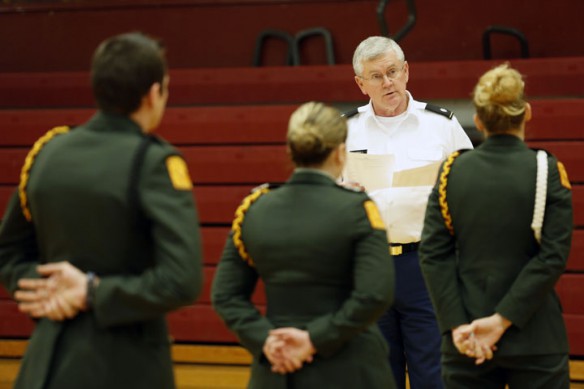
Lt. Col. Steve Darnall informs JROTC cadets at McLean County High School about an upcoming competition against other JROTC programs in the state.
Photo by Amy Wallot, March 12, 2013
By Matthew Tungate
matthew.tungate@education.ky.gov
When 1st Sgt. Sonny Long became Army instructor at Harlan County High School five years ago, he had a freshman in the JROTC program who was in trouble from the first month of school. He skipped classes, argued with everybody, used tobacco constantly and was often in detention.
“I couldn’t hardly stand to be around him much myself,” Long said.
As a sophomore, the student made big improvements while in JROTC class but was still getting in trouble in other classes. The next year, Long gave him a higher rank and explained to the student that he would be held responsible for all of his actions, not just in JROTC. The result was that the student didn’t spend much time in detention, earned higher grades and exhibited newfound self-esteem. By his senior year, the student had learned how to interact with other people, lead them and earn their respect.
“I had over 15 teachers and two principals tell us that we had performed a miracle with him. He was thought of as the most likely student to drop out of high school when he was 16 years old,” Long said. “He graduated high school and is now employed full time. I grew as much during this time as he did. He taught me a lot of lessons that I will value the rest of my life.”
This story and many others show that JROTC is training for life, not just the military, according to Long and other JROTC instructors. Now the Kentucky Department of Education (KDE) has changed its accountability model to reflect that belief. Beginning this year, KDE’s Office of Career and Technical Education (CTE) recognizes the military as a viable career pathway within the Government and Public Safety Career Cluster. As such, JROTC will be included in the college and career readiness accountability model.
That means that a student who has two credits in JROTC classes, is enrolled in a third class, successfully passes the Armed Services Vocational Aptitude Battery (ASVAB) and receives the JROTC three- or four-year Certificate of Training is considered career ready, according to Kiley Whitaker in the College and Career Readiness Branch of KDE.
“We’ve always believed going into military is a valid career,” Whitaker said. “Now KDE is in the process of developing pathways that lead to that, and we’ve not had that in the past.”
Whitaker said there are about 99 high schools with Air Force, Army, Marines and Navy JROTC programs throughout the state.
“Now JROTC is recognized as a CTE program, and schools can receive accountability credit for the JROTC program,” he said. “A school with a JROTC program has the opportunity to increase its college- and career-readiness score.”
Lt. Col. Mark Lathem, senior Army instructor at Ohio County High School, said JROTC is not about directing students toward the military but rather improving their chances of success after high school no matter what they choose to do. Only about 5 percent of JROTC cadets at his school join the military, he said.
“Our mission statement is ‘To motivate young people to be better citizens,’ and everything we do supports this objective,” Lathem said. “We prepare students to be responsible leaders while making them aware of their rights and responsibilities as American citizens and members of a community.”
JROTC teaches personal responsibility, leadership, decision-making and problem-solving strategies, planning and organization skills, anger management, conflict mediation and resolution, etiquette, and financial management, he said.
Lt. Col Steve Darnall, senior Army instructor at McLean County High School, believes JROTC prepares students for careers outside the military more than in it. About 10 percent of JROTC students there join the military, he said.
“JROTC is a challenging and rigorous course designed to develop leadership and citizenship in all students. In the ideal setting, academically strong students are paired with academically challenged students to learn from each other. Both are capable of motivating the other to step out of their comfort zone and interact with students they may otherwise never meet or get to know,” he said.
Long, who was in the first JROTC class at Pulaski County High School in 1982, said there were only three such classes available when he was in high school. Now there are enough classes that students could take eight years’ worth and not repeat a class. The curriculum also can be tailored to address needs in a school or community, he said.
“We teach the students the value of hard work and that they will reap rewards for high performance,” Long said. “We teach them this by awarding ribbons to them for their uniform.”
Lathem said one of the biggest benefits he sees in cadets is in the way their self-confidence grows as they progress through the program.
“To watch a student who is too shy to speak in front of his or her classmates grow to the point where he or she not only feels comfortable speaking publicly but also demonstrates the ability to confidently lead others is immensely gratifying,” he said.
Long said he knows a lot of educators mistakenly believe the military is for the uneducated. However, it is not only a viable career, but a desirable one, he said.
“Our military is the most educated military in the world. It is also one of the most lucrative jobs in the workforce now. It has the best educational benefits of any career. It’s one of the few jobs left in the world that still has a pension for retirement,” Long said. “I think there should be even more emphasis put on our children joining the United States Armed Forces. What could possibly more noble than that?”
MORE INFO …
Kiley Whitaker, kiley.whitaker@education.ky.gov, (502) 564-3472













Leave A Comment